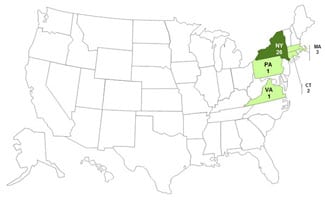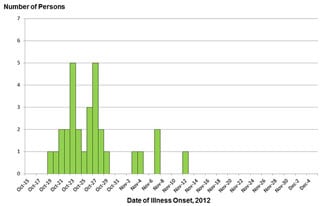Multistate Outbreak of Shiga Toxin-producing Escherichia coli O157:H7 Infections Linked to Organic Spinach and Spring Mix Blend (Final Update)
Posted December 10, 2012 4:30 PM ET
This particular outbreak appears to be over. However, E. coli is still an important cause of human illness in the United States. More information about E. coli, and steps people can take to reduce their risk of infection, can be found on the CDC E. coli Web Page.
- Read the Advice to Consumers »
- A total of 33 persons infected with the outbreak strain of Shiga toxin-producing Escherichia coli O157:H7 (STEC O157:H7) were reported from five states.
- 46% of ill persons were hospitalized. Two ill persons developed hemolytic uremic syndrome (HUS), a type of kidney failure, and no deaths were reported.
- Collaborative investigation efforts of state, local, and federal public health and regulatory agencies linked this outbreak to pre-packaged leafy greens produced by State Garden of Chelsea, Massachusetts.
- Traceback investigations of pre-packaged leafy greens purchased by ill persons identified State Garden as a common producer, but a source of contamination has not been identified. The U.S. Food and Drug Administration (FDA) continues its investigation to identify the source of the contamination.
- This particular outbreak appears to be over. However, E. coli is still an important cause of human illness in the United States. More information about E. coli and steps people can take to reduce their risk for infection can be found on the CDC E. coli homepage.
Introduction
CDC collaborated with public health officials in several states and the U.S. Food and Drug Administration (FDA) to investigate a multistate outbreak of Shiga toxin-producing Escherichia coli O157:H7 (STEC O157:H7) infections. Results from this investigation linked this outbreak to pre-packaged leafy greens produced by State Garden of Chelsea, Massachusetts.
Public health investigators used DNA “fingerprints” of E. coli bacteria obtained through diagnostic testing with pulsed-field gel electrophoresis, or PFGE, to identify cases of illness that were part of this outbreak. They used data from PulseNet, the national subtyping network made up of state and local public health laboratories and federal food regulatory laboratories that performs molecular surveillance of foodborne infections.
The type of bacteria responsible for this outbreak was among those referred to as Shiga toxin-producing E. coli or STEC. STEC bacteria are grouped by serogroups (e.g., O157 or O145). The STEC serogroup found most commonly in U.S. patients is E. coli O157.
A total of 33 ill persons infected with the outbreak strain of STEC O157:H7 were reported from five states. The number of ill people identified in each state with the outbreak strain was as follows: Connecticut (2), Massachusetts (3), New York (26), Pennsylvania (1), and Virginia (1).
Among persons for whom information was available, illness onset dates ranged from October 18, 2012 to November 12, 2012. Ill persons ranged in age from 4 years to 66 years, with a median age of 24 years. Sixty-three percent of ill persons were female. Among 28 ill persons with available information, 13 (46%) were hospitalized. Two ill persons developed hemolytic uremic syndrome (HUS), a type of kidney failure. No deaths were reported.
This particular outbreak appears to be over. However, E. coli is still an important cause of human illness in the United States. More information about E. coli and steps people can take to reduce their risk for infection can be found on the CDC E. coli homepage.
Investigation of the Outbreak
Epidemiologic, laboratory, and traceback investigations conducted by officials in local, state, and federal public health, agriculture, and regulatory agencies linked this outbreak to pre-packaged leafy greens, produced by State Garden of Chelsea, Massachusetts.
State public health officials interviewed ill persons to obtain information regarding foods they might have eaten and other exposures in the week before illness. Thirty (97%) of 31 ill persons reported eating pre-packaged leafy greens. Fifteen (48%) of 31 ill persons for whom information was available reported eating Wegmans brand Organic Spinach and Spring Mix blend in the week before becoming ill. In total, 25 (81%) of 31 ill persons for whom information was available reported eating a variety of different brands of pre-packaged leafy greens produced by State Garden.
Testing conducted by the New York Department Health Wadsworth Center Laboratories isolated the outbreak strain of STECO157:H7 from four leftover packages of Wegmans brand Organic Spinach and Spring Mix blend collected from four ill persons’ homes.
Traceback investigations of pre-packaged leafy greens purchased by ill persons identified State Garden as a common producer, but a source of contamination was not identified. FDA continues its investigation into the source of the contamination.
On November 2, 2012, Wegmans voluntarily recalled its 5-ounce and 11-ounce clam shell packages of Organic Spinach and Spring Mix blend, a product produced by State Garden. State Garden issued a consumer advisory regarding the product packaged on October 12 and 13, 2012.
Final Case Count Update
A total of 33 persons infected with the outbreak strain of Shiga toxin-producing E. coli O157:H7 were reported from five states. Five new cases were reported from two states: Massachusetts (1) and New York (4).
Among persons for whom information was available, illness onset dates ranged from October 18, 2012 to November 12, 2012. Ill persons ranged in age from 4 years to 66 years, with a median age of 24 years. Sixty-three percent of ill persons were female. Among 28 persons with available information, 13 (46%) patients were hospitalized. Two ill persons developed hemolytic uremic syndrome (HUS), a type of kidney failure, and no deaths were reported.
November 17, 2012
CDC is collaborating with public health officials in several states and the U.S. Food and Drug Administration (FDA) to investigate a multistate outbreak of Shiga toxin-producing Escherichia coli O157 (STEC O157) infections. Preliminary results from this ongoing investigation indicate that Wegmans brand Organic Spinach and Spring Mix blend produced by State Garden of Chelsea, Massachusetts, is one likely source of this outbreak.
Public health investigators are using DNA “fingerprints” of E. coli bacteria obtained through diagnostic testing with pulsed-field gel electrophoresis, or PFGE, to identify cases of illness that may be part of this outbreak. They are using data from PulseNet, the national subtyping network made up of state and local public health laboratories and federal food regulatory laboratories that performs molecular surveillance of foodborne infections.
The type of bacteria responsible for this outbreak is among those referred to as Shiga toxin-producing E. coli or STEC. STEC bacteria are grouped by serogroups (e.g., O157 or O145). The STEC serogroup found most commonly in U.S. patients is E. coli O157.
A total of 28 ill persons infected with the outbreak strain of STEC O157:H7 have been reported from five states. The number of ill people identified in each state with the outbreak strain is as follows: Connecticut (2), Massachusetts (2), New York (22), Pennsylvania (1), and Virginia (1).
Among persons for whom information is available, illness onset dates range from October 18, 2012 to November 3, 2012. Ill persons range in age from 4 years to 66 years, with a median age of 24 years. Sixty-eight percent of ill persons are female. Among 24 ill persons with available information, 10 (42%) reported being hospitalized. Two ill persons have developed hemolytic uremic syndrome, a type of kidney failure. No deaths have been reported.
This PFGE pattern has very rarely been seen before in PulseNet. It has been seen only 7 times prior to this outbreak. Illnesses that occurred after October 30, 2012 might not be reported yet due to the time it takes between when a person becomes ill and when the illness is reported. This outbreak can be visually described with a chart showing the number of persons who became ill each day. This chart is called an epi curve. Please see the Timeline for Reporting of E. coli Cases for more details on the reporting process.

